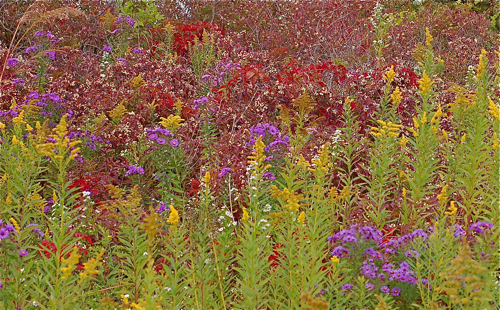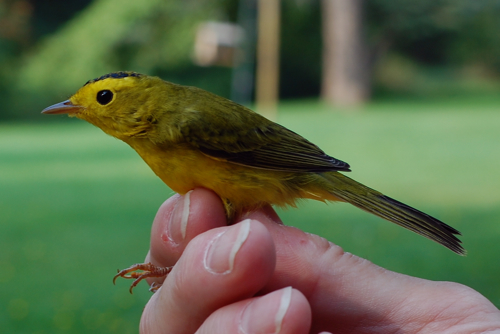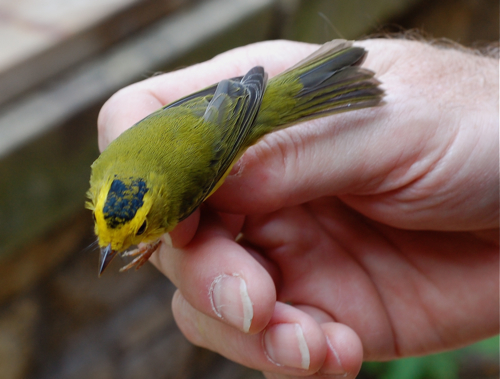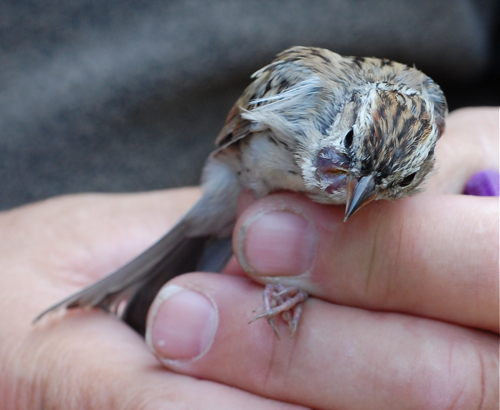WARNING! THERE ARE SOME KIND OF GROSS BIRD TUMOR PHOTOS IN THIS POST. Don't worry, I'll end on a nice cleansing post.

The colors at Carpenter Nature Center are outstanding right now. This amazing palette will last over the next month or so, so if you need a day to just look at some beautiful late summer flowers, this is the place to be.
Many of the birds in the nets for Friday's banding were pretty too, like this Wilson's warbler. I wonder if this bird is on his way to Guatemala? It was the most common warbler I remember seeing there last February. Between the ones I see around MN, Las Vegas, and Guatemala, I think this is the most common warbler I have seen all 2009, I think I have seen more of these than I have yellow-rumped warblers.
Here's an above view of that Wilson's warbler, a hatch year male. His cap is growing in well and his outer tail feathers are pointed. McGill Bird Observatory has a good website with photos showing how they age and sex birds in the hand (certainly is easier to read than Pyle).
Hey! For some crazy shots of a "washed out Wilson's warbler" found during banding, check out Bill Schmoker's blogWil.
Some days when we band birds, it is fairly easy to get them out of the nets, other days it seems as though every bird gets tangled up in some weird way, how will I ever get them out. This was one of those days. However, get them out we did. We did see two birds that appeared to be having some health issues.
One bird was a field sparrow. I did not get photos of it, but as I took it out of the net, I could see that its head was missing several feathers, almost like a bald cardinal. Not only that, the exposed skin looked dry and had what looked like sore patches. The bird also had a bit of bleeding around the neck. As soon as it was out, it was let go. This was not a situation where the bird could have been taken to a rehab center and there was no point in furthering any stress. Whatever this poor field sparrow had going, banding was not going to help. I had to make sure to wash thoroughly with anti-bacterial soap, so as not to risk spreading whatever the bird had.
We also had a chipping sparrow fly in to the nets with a tumor.
Apart from the tumor, this bird appeared healthy. The lump looked like it might be a blister, but the tumor was rock solid.
If you look at it from the front, it appears as though it starts right at the gape. It's hard when these come in. As a human, you would like to do something to help, to make a bird's life easier. However, would wildlife rehab really help a bird like this? Would it be better to let it live out what life it has in the wild than to have spend a few days terrified in a clinic where it most likely will be put down? Birds with illnesses and injuries are eaten by predators, it's a valuable source of food for migrating hawks, wouldn't it be better to let that be the ultimate end, where it continues to the cycle of life, rather than die quietly indoors? And we certainly were seeing hawks passover--especially sharp-shinned hawks.
It's never an easy call, but something that banders are faced with from time to time.
I end with a photo of goldenrod surrounded by some of the other flowers and leaves. If you are looking for a place to visit with some great color, Carpenter is it at least for the next month.





